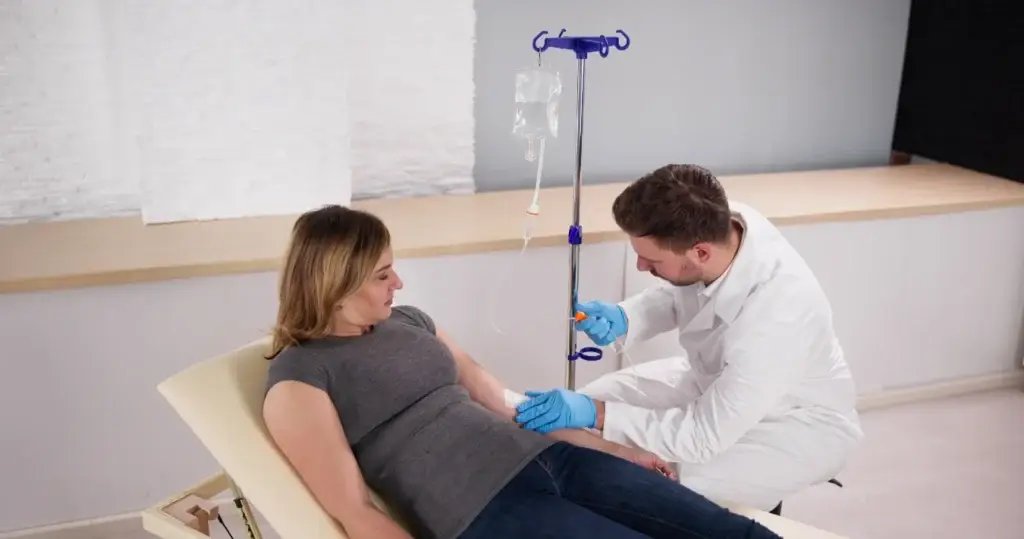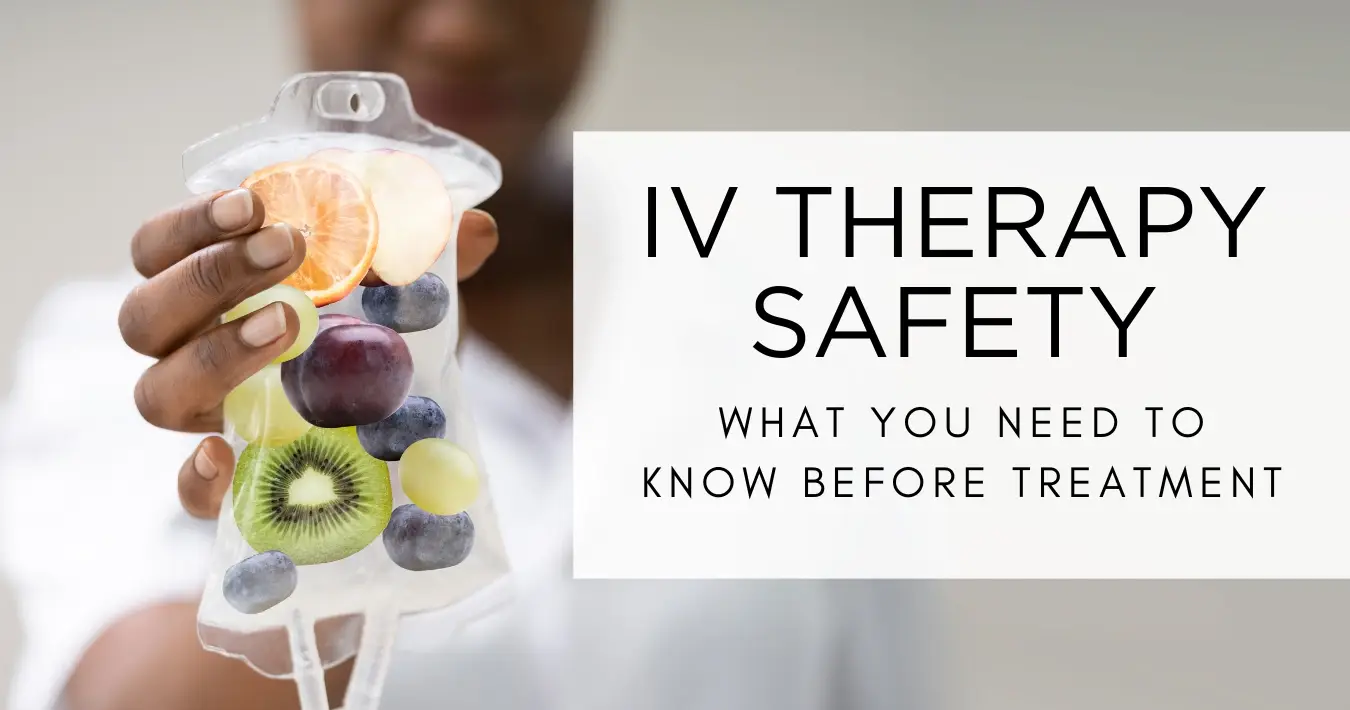IV Therapy Safety Overview
IV therapy, when performed by qualified healthcare professionals using proper protocols, is generally safe for healthy adults. However, like any medical procedure involving needle insertion and medication administration, it carries certain risks that patients should understand before treatment.
Common Side Effects of IV Therapy
Most IV therapy side effects are mild and temporary:
At the Injection Site:
- Minor bruising or tenderness
- Slight swelling or redness
- Temporary discomfort during needle insertion
- Small hematoma (blood under skin)
During Treatment:
- Feeling cold due to room-temperature fluids
- Mild nausea if treatment is administered too quickly
- Lightheadedness from position changes
- Metallic taste from certain vitamins
Rare but Serious Complications
While uncommon, serious complications can occur:
Infection: Poor sterile technique can introduce bacteria into the bloodstream, potentially causing sepsis.
Allergic Reactions: Some individuals may react to specific vitamins, minerals, or preservatives in IV solutions.
Electrolyte Imbalances: Improper formulations can disrupt sodium, potassium, or magnesium levels.
Fluid Overload: Excessive fluid administration can strain the cardiovascular system.
Nerve Damage: Improper needle placement may injure nearby nerves.
Air Embolism: Air bubbles entering the bloodstream, though extremely rare with proper technique.
Who Should Avoid IV Therapy
Certain individuals face higher risks and should consult physicians before treatment:
Medical Conditions:
- Kidney disease or impaired kidney function
- Heart failure or cardiovascular disease
- Severe liver disease
- Active cancer undergoing treatment
- Autoimmune disorders
- Blood clotting disorders
Medications:
- Blood thinners (warfarin, heparin)
- Diuretics
- Blood pressure medications
- Chemotherapy drugs
Special Populations:
- Pregnant or breastfeeding women
- Children under 18
- Elderly individuals with multiple health conditions
- People with severe allergies or anaphylaxis history
Safety Standards for IV Therapy Providers
Choose providers who maintain high safety standards:
Medical Supervision:
- Licensed physicians or nurse practitioners on staff
- Medical director oversight of all protocols
- Emergency response procedures in place
- Staff trained in CPR and emergency care

Sterile Environment:
- Clean, clinical setting similar to medical office
- Single-use, sterile equipment for each patient
- Proper hand hygiene and sterile technique
- Safe disposal of medical waste
Quality Ingredients:
- Pharmaceutical-grade vitamins and minerals
- FDA-approved IV fluids and solutions
- Proper storage and handling of medications
- Batch testing and quality control
Patient Screening:
- Comprehensive health questionnaire
- Review of medications and allergies
- Vital sign monitoring during treatment
- Documented informed consent process
Pre-Treatment Safety Screening
Reputable providers should assess:
Medical History:
- Current medications and supplements
- Known allergies or adverse reactions
- Previous IV therapy experiences
- Chronic health conditions
Current Health Status:
- Recent illness or infections
- Pregnancy status
- Current symptoms or concerns
- Vital signs (blood pressure, heart rate)
Treatment Goals:
- Specific health objectives
- Realistic expectations
- Appropriate formulation selection
- Treatment frequency recommendations
During Treatment Safety Monitoring
Professional providers monitor patients for:
Vital Signs:
- Blood pressure changes
- Heart rate variations
- Oxygen saturation levels
- Temperature monitoring
Patient Comfort:
- Pain or discomfort levels
- Nausea or dizziness
- Anxiety or restlessness
- Overall treatment tolerance
IV Site Assessment:
- Proper needle placement
- Signs of infiltration or extravasation
- Swelling or discoloration
- Patient reports of pain or burning
Post-Treatment Safety Guidelines
After IV therapy, patients should:
Immediate Aftercare:
- Apply pressure to insertion site if bleeding
- Keep bandage clean and dry for 24 hours
- Avoid heavy lifting with treated arm
- Stay hydrated with oral fluids
Monitor for Complications:
- Watch for signs of infection (fever, increased pain, red streaking)
- Report severe or worsening symptoms
- Contact provider with concerns
- Seek emergency care for severe reactions
Red Flags Requiring Immediate Medical Attention
Seek emergency care for:
- Difficulty breathing or chest pain
- Severe allergic reaction (hives, swelling, difficulty swallowing)
- High fever or chills
- Severe pain or swelling at IV site
- Red streaking from injection site
- Persistent nausea or vomiting
- Dizziness or fainting
Choosing Safe IV Therapy Providers
Research providers thoroughly:
Credentials:
- Medical licensing and certifications
- Professional association memberships
- Insurance and bonding status
- Patient safety record
Facility Standards:
- Clean, professional environment
- Proper medical equipment
- Emergency preparedness
- Positive patient reviews
Consultation Process:
- Thorough health screening
- Realistic expectation setting
- Detailed consent process
- Follow-up care availability
Questions to Ask Your Provider
Before treatment, inquire about:
- Staff qualifications and training
- Emergency response procedures
- Ingredient sourcing and quality
- Side effect management protocols
- Follow-up care availability
- Success and complication rates
Making Informed Decisions
IV therapy can offer wellness benefits when:
- Performed by qualified professionals
- Appropriate for your health status
- Part of comprehensive wellness plan
- Realistic expectations are maintained
Prioritize safety over convenience by choosing reputable providers who maintain high medical standards and prioritize patient wellbeing above profit.

No responses yet